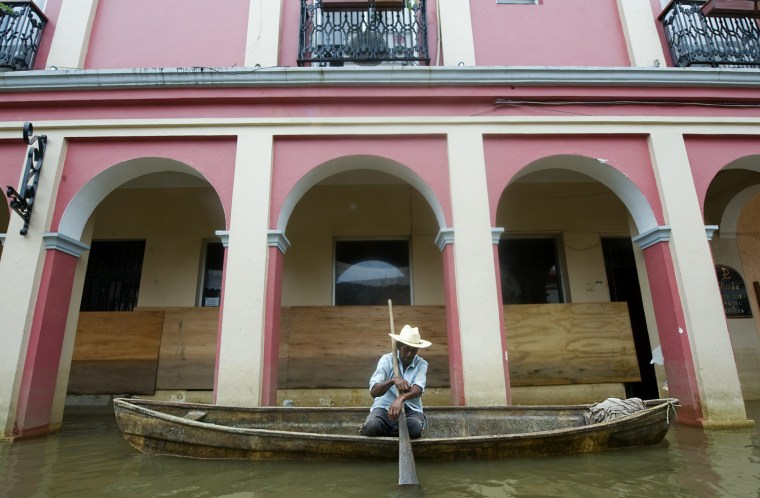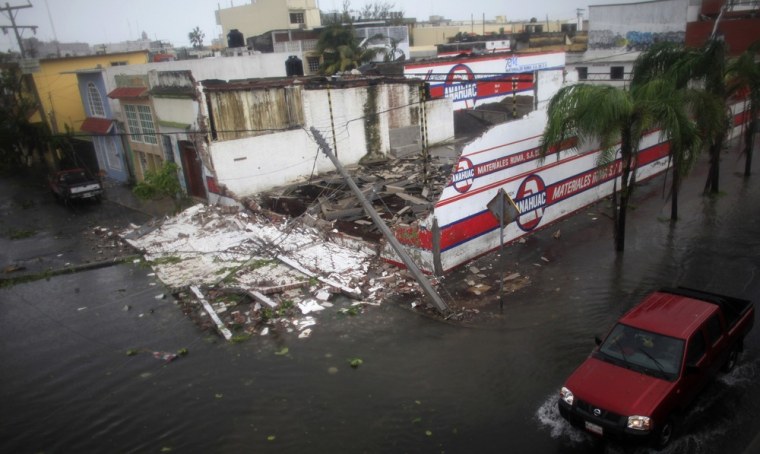Hurricane Karl smashed into Mexico's Gulf Coast on Friday, killing at least two people and forcing the country to shut down its only nuclear power plant and its central Gulf Coast oil platforms.
The storm quickly weakened as it swirled inland and became a tropical depression late Friday, the U.S. National Hurricane Center in Miami said.
Karl was expected to dissipate over mountains, but authorities across central Mexico prepared for more possible flash floods and mudslides from its rain. Mexico City officials put hospitals on alert and sent workers to evaluate hillside neighborhoods and flood-risk zones.
A landslide buried a house in the town of Nexticapan, killing a 61-year-old woman and a 2-year-old girl and injuring two other people, said Aru Becerra, a spokeswoman for Civil Protection in Puebla, a state bordering the Mexican capital.
The storm had sustained winds of 115 mph when it hit land at midday about 10 miles northwest of the port city of Veracruz. Its winds were down to 35 mph by nightfall.
Karl caused widespread damage in Veracruz, knocking down trees, billboards and power poles, said the port city's civil protection chief, Isidro Cano Luna. He said there had not been a storm like it since Hurricane Janet hit in 1955.
Veracruz state Gov. Fidel Herrera surveyed the heaviest damage in the coastal towns north of the port. Food huts along the beach were destroyed in the fishing town of Chachalaca. In Ursulo Galvan, 10 homes collapsed or lost their roofs.
Some streets were impassable and about 70 homes were flooded.
more than 22,000 people lost power, although electricity was restored to many neighborhoods within hours.
"We went through several hours of anxiety but also of organization, coordination," Herrera said. "Fortunately, we are all still here. The death toll (in the state) was zero. This was my biggest challenge yet as governor."
A stretch of coastal road farther north in Nautla was washed out.
Rains in the mountain regions could cause flash floods and mudslides, the U.S. National Hurricane Center in Miami said.
Officials in Mexico City and neighboring Cuernavaca put crews on alert and designated schools and other buildings as possible shelters.
The Mexican capital was in a state of "blue alert," meaning the risk was considered moderate, city Civil Protection Secretary Elias Moreno said.
Not since Hurricane Janet hit in September 1955 had the area seen such a storm, said Veracruz civil protection chief Isidro Cano Luna.
State oil company Petroleos Mexicanos closed 14 production wells in the northern part of Veracruz state and evacuated workers from some platforms in the Gulf.
Workers also were evacuated from the shuttered Laguna Verde nuclear power plant, Mexico's largest electricity producer, along with residents in the nearby town of Farallon and in the coastal towns of Cardel and Palma Sola. The latter was reportedly hardest hit so far by flooding, with a resident saying that at least 20 families were trapped.
"We asked for help because right now we have no way to get out," said Palma Sola resident Agustin Tlapa. "We're totally flooded."
About 80,000 people have had their homes damaged and nine people have been killed in flooding from previous heavy rains in southern Veracruz since Aug. 19. Officials expressed concern Karl could raise river levels again, just as some residents were thinking of returning to their homes.

Igor, Julia churn in the Atlantic
Meanwhile, Hurricane Igor strengthened to a Catergory 2 storm and became better organized on a track to approach Bermuda late Sunday, the hurricane center said. Its top winds were 110 mph Friday night.
The British territory's government issued a hurricane warning. Forecasters said Igor could dump 5 to 8 inches of rain on Bermuda and cause a storm surge with large and destructive waves.
Farther east over the Atlantic, Hurricane Julia weakened to a tropical storm with 70 mph winds.
With 11 named storms so far, the 2010 Atlantic hurricane season has been more active, but damage has been relatively limited as several storms have fizzled out in before reaching land.
The rapid early strengthening of many storms this year near the coast of Africa has pushed them on northwest tracks away from vulnerable areas. But with two months left in the hurricane season it is too early to say there will not be another dangerous storm, said hurricane expert Rick Knabb of The Weather Channel.
"We need to wait until the season is over, before we can make a judgment on the forecasts," Knabb said.
